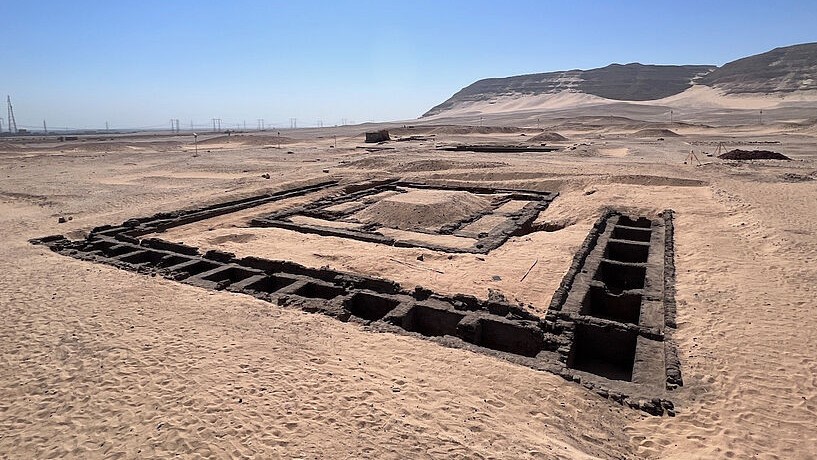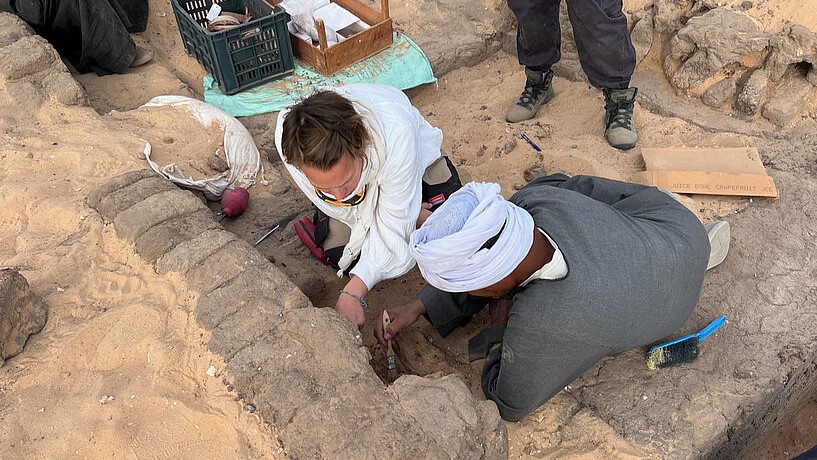Egypt had an unusually powerful 'female king' 5,000 years ago, lavish tomb suggests
Excavations of the tomb of ancient Egyptian queen Meret-Neith reveal she was an influential figure with "unusually high levels of authority," but experts are divided about whether she actually reigned.
New excavations of the ancient Egyptian queen Meret-Neith's tomb have yielded riches, suggesting she may have been Egypt's first female ruler, archaeologists say. However, some experts question whether she actually reigned.
Although Meret-Neith's tomb was discovered in 1900, recent excavations reveal that the queen's monumental grave was piled with hundreds of jars containing 5,000-year-old grape seeds — essentially, the well-preserved remnants of wine — and other grave goods fit for a royal, according to a statement. Inscriptions discovered inside the tomb, located in Abydos, in central Egypt, also indicate Meret-Neith held an important role in the treasury and served in other governmental positions around 3000 B.C.
"It most certainly is a tremendously important tomb," Ronald Leprohon, a professor emeritus of Egyptology at the University of Toronto who did not participate in the recent excavations, told Live Science in an email.
Meret-Neith, whose name means "beloved of the goddess Neith," was the wife of King Djet — the third king of the first dynasty of ancient Egyptian rulers, according to Leprohon — and the mother of his heir, King Den. Her tomb complex includes the graves of 41 courtiers and servants and was made with mud bricks, clay and wood over several construction phases. An earlier finding showed that the queen's name features after her son's on an inscribed list of rulers discovered in his tomb at Saqqara, followed by the title "king's mother," which suggests she ruled as regent during Den's youth, Leprohon said.
Related: What did Cleopatra, Egypt's last pharaoh, really look like?
Her regency could explain why she was buried with such pomp in the royal cemetery at Abydos, Leprohon said. "The very fact of having added her name to the list of kings shows that something highly important had to have happened with Meret-Neith," he said.
But exactly what occurred remains a mystery, said Christiana Köhler, an archaeologist and professor of Egyptology at the University of Vienna in Austria who led the excavations at Abydos. "There is indeed a lot of debate going on among Egyptologists as the evidence is not entirely conclusive," Köhler told Live Science in an email.
Get the world’s most fascinating discoveries delivered straight to your inbox.
Some experts believe Meret-Neith held the same powers as those granted to male kings, based on the previously discovered list of rulers and other clues. "No other queen in the early dynastic period possessed so many royal privileges," Jean-Pierre Patznick, an Egyptologist at Sorbonne University in France who was not involved in the recent excavation, wrote in the "Proceedings of the Seventh European Conference of Egyptologists" (Archaeopress Publishing, 2017). "Meret-Neith became the very first woman pharaoh of history."
Others are not so sure, arguing that women rarely reigned in ancient Egypt, especially this early on.
"Wives and daughters were not typically considered in terms of royal successions," Margaret Maitland, principal curator of ancient Mediterranean collections at National Museums Scotland, told Live Science in an email. Nevertheless, the new evidence suggests Meret-Neith had "an unusually high level of authority for a royal woman," Maitland said.
Elizabeth Carney, a professor emerita of history at Clemson University in South Carolina, agreed. "It really would be striking if you had a female king as early as the first dynasty," she told Live Science in an email.
Even if Meret-Neith did rule over Egypt 5,000 years ago, she probably wasn't considered a "pharaoh," Leprohon said. The term — meaning "great house" in ancient Egyptian — likely only came into use much later and referred to monarchs from the 18th dynasty (circa 1550 to 1295 B.C.) onward, he said.
"A clever suggestion from one of our colleagues is that Hatshepsut first used the term Great House to refer to the monarch because it was gender-neutral," Leprohon said. Referring to ancient Egyptian rulers that preceded Hatshepsut as "pharaohs" may therefore be anachronistic, he added.
Questions about the ancient queen's status and influence are "at the core of our ongoing research project that deals with the tomb of queen Meret-Neith at Abydos," Köhler said. "I'm almost sure that once we have completed the excavation of this huge complex, we will know more."

Sascha is a U.K.-based staff writer at Live Science. She holds a bachelor’s degree in biology from the University of Southampton in England and a master’s degree in science communication from Imperial College London. Her work has appeared in The Guardian and the health website Zoe. Besides writing, she enjoys playing tennis, bread-making and browsing second-hand shops for hidden gems.






